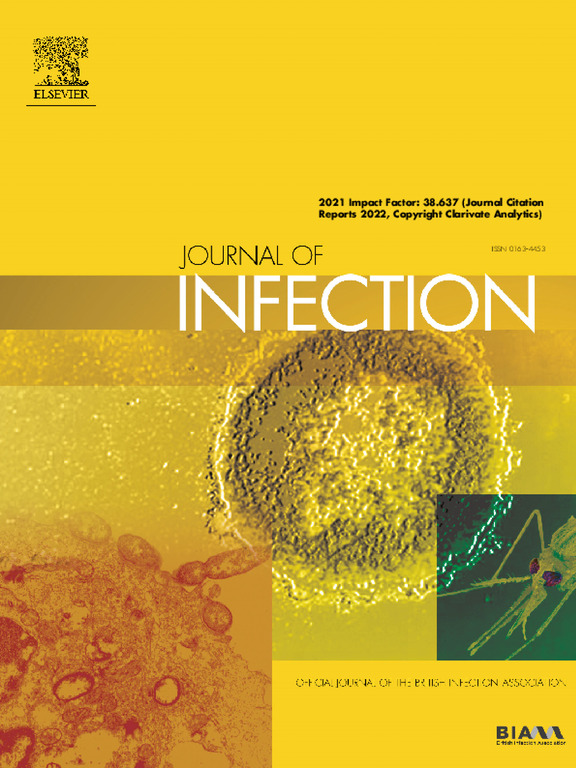2023/24冬季(2023年9月至2024年3月)英国医护人员SARS-CoV-2、流感、呼吸道合胞病毒(RSV)感染和呼吸道疾病的流行及其影响:SIREN队列研究
IF 11.9
1区 医学
Q1 INFECTIOUS DISEASES
引用次数: 0
摘要
背景:在冬季,由于呼吸道感染和工作人员缺勤的增加,卫生保健系统面临额外的压力。我们的目的是确定2023/24年冬季SIREN医护人员(HCW)队列中呼吸道病毒的流行率及其对缺勤的影响。方法:SIREN是一项队列研究,包括相关的检测、疫苗接种、人口统计学、症状和病假数据。无论症状如何,参与者每两周接受一次SARS-CoV-2、流感和RSV多重PCR检测。根据病毒感染和疫苗接种状况,计算了请病假的参与者的比例、病假天数的总数和中位数。使用Logistic回归来估计病假与疫苗接种状况之间的关联。结果:纳入5287例受试者,女性78.3%,中位年龄54岁。在1,659名参与者中,有1,828例感染(1,161例SARS-CoV-2; 387例RSV; 280例流感感染)。流感和RSV高峰在12月(1.2%;1.9%),SARS-CoV-2高峰在9月和12月(4.0%;4.3%)。无论是否有已知感染,35.8%(1892 / 5287)的人请了病假,总共请了10168天病假(平均每人5天,范围1-98天)。讨论:呼吸系统疾病在冬季给SIREN医护人员造成了沉重的负担,这三种病毒都起到了作用。工作人员数量的减少和带病工作的压力对医疗弹性有影响。资助:英国卫生安全局、英国卫生和社会保障部,北爱尔兰、威尔士和苏格兰政府提供资助,并提供惠康基金参考。本文章由计算机程序翻译,如有差异,请以英文原文为准。
Prevalence and impact of SARS-CoV-2, influenza, respiratory syncytial virus (RSV) infection and respiratory illness on UK healthcare workers during winter 2023/24 (September 2023 to March 2024): SIREN cohort study
Background
During the winter, healthcare systems experience additional pressures due to increases in respiratory infections and staff absence. We aimed to determine the prevalence of respiratory viruses and impact on sickness absence in the SIREN healthcare worker (HCW) cohort during winter 2023/24.
Methods
SIREN is a cohort study with linked testing, vaccination, demographic, symptoms and sick leave data. Participants undergo fortnightly multiplex PCR testing for SARS-CoV-2, influenza and RSV, regardless of symptoms. The proportion of participants who took sick leave, the total number and median of sick leave days taken was calculated, overall and stratified by viral infection and vaccination status. Logistic regression was used to estimate the association between sick leave and vaccination status.
Results
A total of 5287 participants were included, 78·3% female, median age 54 years. There were 1828 infections (1161 SARS-CoV-2; 387 RSV; 280 influenza infections) among 1659 participants. Influenza and RSV peaked in December (1·2%; 1·9%), SARS-CoV-2 peaked in September and December 2023 (4·0%; 4·3%).
Regardless of a known infection, 35.8% (1892/5287) took sick leave, resulting in 10,168 days (median 5 days per person; range 1–98 days).
Discussion
Respiratory illness caused a substantial burden on the SIREN healthcare workforce over winter, with all three viruses contributing. Reduced number of staff at work and pressures to work through illness have implications for healthcare resilience.
求助全文
通过发布文献求助,成功后即可免费获取论文全文。
去求助
来源期刊

Journal of Infection
医学-传染病学
CiteScore
45.90
自引率
3.20%
发文量
475
审稿时长
16 days
期刊介绍:
The Journal of Infection publishes original papers on all aspects of infection - clinical, microbiological and epidemiological. The Journal seeks to bring together knowledge from all specialties involved in infection research and clinical practice, and present the best work in the ever-changing field of infection.
Each issue brings you Editorials that describe current or controversial topics of interest, high quality Reviews to keep you in touch with the latest developments in specific fields of interest, an Epidemiology section reporting studies in the hospital and the general community, and a lively correspondence section.
 求助内容:
求助内容: 应助结果提醒方式:
应助结果提醒方式:


